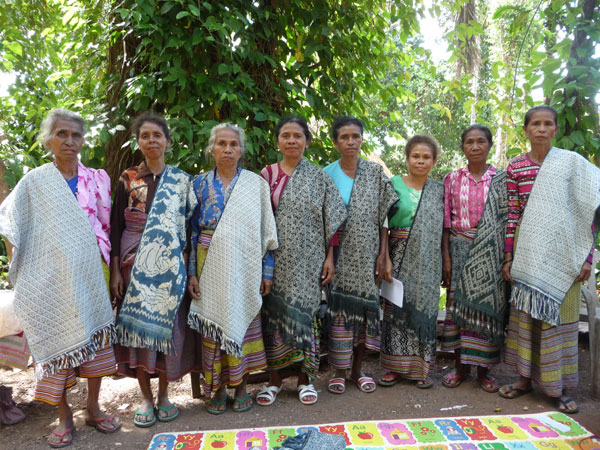The Revitalization of Traditional Textiles in Timor
The island of Timor and particularly West Timor is perhaps the most prolific in the production of a wide variety of traditional textiles that are still used today for rituals and ceremonies. “The diversity of color and types of textiles is what keeps my interest in working with weavers on this island,” says Wenten. “Although Threads of Life has worked for many years in West Timor we are still finding small enclaves of weavers making types of textiles tha we haven’t seen before.” Wenten reflects on some of these new areas in this report.

Timor has more diversity of traditional textiles than other islands where Threads of Life works

An old indigo-dyed ikat textile with gecko and bird motifs
The Village of Abi
Wenten laughs recounting; “During the years of travelling with our Timor driver, Om Hanis, I have often heard him say, “On the other side of that mountain there are still people working with natural dyes.” So 2014 was the year we decided to journey into the area over the mountain to see if this was in fact the case. In the village of Abi in Amanuban we met three dyers who still knew how to use natural dyes. They had stopped using natural dyes several years ago when synthetic dyes were made available cheap in the local stores. Initally we discussed textiles by looking at some of the older textiles that they had and asking questions about motifs and colors that this area is famous for. Their work with synthetic dyes indicated that they still take time to carefully tie their ikat patterns and we also noticed that indigo and other plants used in the blue process were realatively abundant. They were clearly willing to work together to create natual dye textiles again.
The village of Oe Ekam
Abi and Oe Ekam are both remnants of the old kingdom of Amanuban. While these two villages are from the same area, their textiles are quite different in terms of structure and motifs. “It is a shame to let these beautiful motifs and the culture they have represented become extinct,” says Wenten. So late in 2013 he began to talk to the weavers about reviving these textiles. We found two weavers who are willing to work with us to weave textiles using these old motifs and natural dyes. “Where there is the will of two weavers, we feel sure that we will be successful in reviving this art,” reflects Wenten.

Oe Ekam weavers Ibu Efrosina Sakan and Ibu Marcelina Babu

Ibu Wihelmina Nesi weaving in Manunain
The Village of Manunain
Manunain is a village in the old kingdom of Insana. Insana has mostly left behind their old ikat and indigo work in favor of synthetic dyes and the warp wrap technique called buna. The Insana textiles traditionally were blue in color and had beautiful motifs such as manu (chicken). The Threads of Life team has looked for a long time to find any weaver still wanting to make the more traditional ikat textiles using natural dyes. We were lucky to find a woman named Ibu Nesi who is still making handspun natural dyed textiles. She has ten indigo dye vats that she inherited from her mother. To achive the same quality of dye that her mother achieved Nesi believes she must follow her mother’s way. Every year she performs a ceremony for these indigo vats so that her ancestors help her with her work.
The Village of Inbate
For years Threads of Life teams have searched in the hills above Kefamananu, looking for indigo dyers and weavers. A few years ago we came across a group on the border of Oecusse, Timor Leste. While synthetic dyes are now being used, weavers were very enthusiastic to begin using indigo again. As with all new groups, we began by ordering small pieces like shoulder cloths. Later, when we see weavers have achieved the quality demanded by Threads of Life, we ask them to produce larger textiles with more complex techniques or patterns.

Weavers of Inbate

The trip to Fenun is very difficult and impossible in the rainy season
The Village of Fenun
Deep in the mountains of Amanatun is the village of Fenun where we have worked over the years with craftsmen who carve horn for lime containers. We only began to work with weavers here last year and there are still several women who use natural dyes in this remote village. What excites us about reviving textiles in this area is that the motifs are different than other vilages. We have seen over the years that when a textile tradition is revived, the pride of the community in its traditional culture is also revived. So we will continue to visit this community despite roads that are barely passable in the dry season and definitely not passable in the monsoon!
The Village of Molo
Our main reason for working in the area of Molo with the village of Nunbena is to revive the old tapestry woven textiles that were worn by the Meo warriors of old. We have been lucky to work with the village head, Eben Oematan, who has encouraged the weavers over the years to work with Threads of Life. Over many years we have worked to get the quality of the tapestry weave (kilim) closer to the fine work of their grandmothers before asking them to weave anything big. They have used the tapestry weave technique called mnaisa to weave small sections of belts for the past four years. This year, and using photographs of old Meo warriors’ custumes we provided, one woman worked on a complete headdress using all natural dyes. “It is quite good! This is why I love this work!” glows Wenten.

The new Meo warrior headdress using natural dyes and tapestry technique

